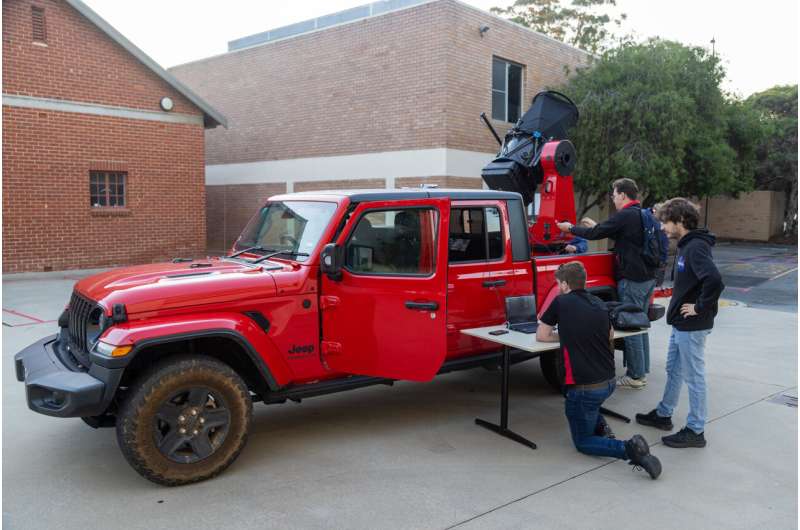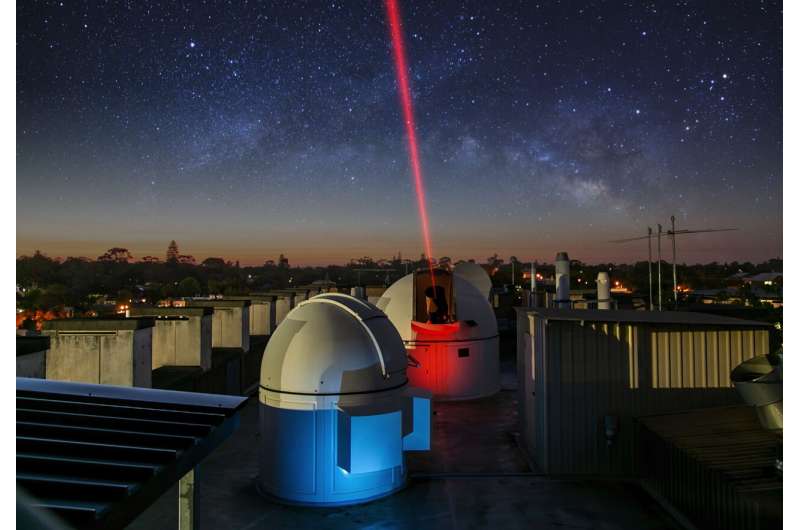
JULY 15, 2024 by International Centre for Radio Astronomy Research
Collected at: https://techxplore.com/news/2024-07-optical-ground-stations-capture-satellite.html
The University of Western Australia’s “TeraNet,” a network of optical ground stations specializing in high-speed space communications, has successfully received laser signals from a German satellite in low Earth orbit. This breakthrough paves the way for a 1,000-fold increase in communication bandwidth between space and Earth.
The TeraNet team, led by Associate Professor Sascha Schediwy from the UWA node at the International Centre for Radio Astronomy Research (ICRAR), received laser signals from OSIRISv1, a laser communication payload from the Institute of Communications and Navigation of the German Aerospace Center (DLR). OSIRISv1 is installed on the University of Stuttgart’s Flying Laptop satellite. The signals were detected using two of the TeraNet optical ground stations during flybys of the satellite last Thursday.
“This demonstration is the critical first step in establishing a next-generation space communications network across Western Australia. The next steps include joining this network to other optical ground stations currently being developed in Australia and across the world,” Associate Professor Schediwy said.
The TeraNet ground stations use lasers, instead of traditional wireless radio signals, to transfer data between satellites in space and users on Earth. Lasers can potentially transfer data at thousands of gigabits per second, because lasers operate at much higher frequencies than radio, so much more data can be packed into every second.
Wireless radio technology has been used to communicate from space since the launch of the first satellite, Sputnik 1, nearly 70 years ago, and the technology has remained relatively unchanged since then. As the number of satellites in space has grown, with each new satellite capable of generating more data, there is now a critical space bottleneck in getting data back to Earth.

Laser communication is perfectly suited to solving this problem, but the downside is that laser signals can be interrupted by clouds and rain. The TeraNet team is mitigating this downside by establishing a network of three ground stations spread across Western Australia. This means that if it’s cloudy at one ground station site, the satellite can download its data to another site with clear skies.
In addition, one of the two TeraNet ground stations that received the satellite laser signal is built on the back of a custom-built Jeep truck. This means it can be rapidly deployed to sites that need ultra-fast space communications, such as remote communities where traditional communications links have been cut off due to natural disasters.
High-speed laser communication from space will revolutionize data transfer for Earth observation satellites, significantly enhance and secure military communication networks, and bolster secure remote operations for sectors such as autonomous mining operations, as well as national disaster planning and responses.
TeraNet will support multiple international space missions operating between low Earth orbit and the moon, using both proven conventional optical communications standards and more advanced optical technologies, including deep-space communication, ultra-high-speed coherent communications, quantum-secured communications, and optical positioning and timing.
The network includes a ground station at UWA, a second ground station at the Mingenew Space Precinct 300 km north of Perth, and a mobile ground station that is being commissioned at the European Space Agency’s New Norcia facility.

Leave a Reply